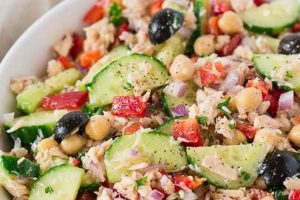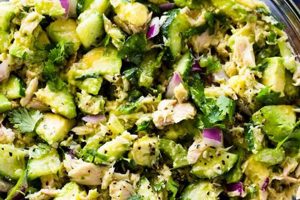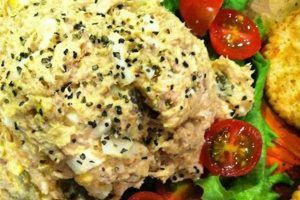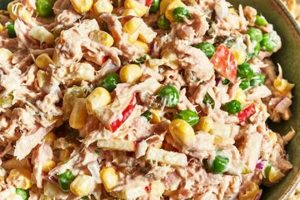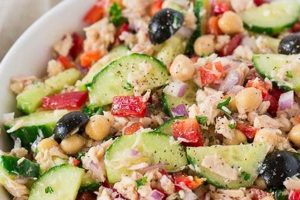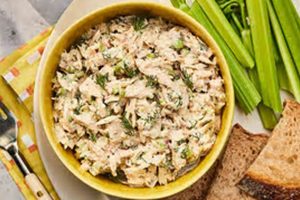A dish featuring diced, cooked tuna as the primary ingredient, often combined with mayonnaise, celery, onion, and seasonings. Variations may include other ingredients such as herbs, spices, hard-boiled eggs, or relish. Using freshly cooked tuna, as opposed to canned, offers a distinct flavor profile and texture, often described as milder and flakier.
Preparing this dish with high-quality, freshly prepared tuna significantly elevates the flavor and nutritional value compared to using canned alternatives. Fresh tuna offers a cleaner, more delicate taste and a richer texture. It also allows for greater control over sodium content and avoids potential additives or preservatives often found in canned products. Historically, access to fresh seafood dictated culinary practices, making dishes like this a mark of proximity to coastal regions and an appreciation for fresh ingredients.
The following sections will delve into selecting and preparing fresh tuna, explore various complementary ingredients and flavor profiles, and provide step-by-step instructions for creating a delightful culinary experience.
Tips for Preparing Fresh Tuna Salad
Optimizing the preparation of tuna salad using fresh tuna requires attention to detail and an understanding of key techniques. The following tips offer guidance on achieving superior results.
Tip 1: Source High-Quality Tuna: Selecting sushi-grade tuna ensures optimal freshness and flavor. Look for firm, vibrant fillets with a clean aroma.
Tip 2: Proper Cooking Technique: Searing or grilling the tuna briefly preserves its natural moisture and delicate texture. Avoid overcooking, which can result in a dry, less flavorful outcome. Aim for an internal temperature of 125-130F (52-54C) for medium-rare.
Tip 3: Careful Cooling and Flaking: Allow the cooked tuna to cool completely before flaking to prevent it from becoming mushy. Gently flake the tuna into bite-sized pieces, avoiding shredding or over-processing.
Tip 4: Balancing Flavors: Achieve a harmonious blend of flavors by using high-quality mayonnaise, crisp celery, and finely diced red onion. Consider adding fresh herbs like dill or chives for a brighter taste.
Tip 5: Seasoning Appropriately: Enhance the natural flavors of the tuna with a judicious use of sea salt, freshly cracked black pepper, and a touch of lemon juice or Dijon mustard.
Tip 6: Mindful Ingredient Incorporation: Gently fold the ingredients together to avoid breaking down the tuna and creating a dense, paste-like consistency.
Tip 7: Chilling for Optimal Flavor: Allowing the salad to chill for at least 30 minutes before serving allows the flavors to meld and enhances the overall experience.
By following these guidelines, one can elevate tuna salad from a simple dish to a culinary delight, showcasing the exquisite flavor and texture of fresh tuna.
The concluding section will offer variations on this classic recipe and suggest serving options for a complete and satisfying meal.
1. Fresh, High-Quality Tuna
The foundation of exceptional tuna salad rests upon the quality of its core ingredient: fresh tuna. Utilizing superior tuna significantly elevates the dish’s flavor profile, texture, and overall culinary experience. This section explores the multifaceted aspects of sourcing and utilizing fresh, high-quality tuna in the context of crafting exceptional tuna salad.
- Sourcing and Selection
Sourcing fresh tuna requires careful consideration. Look for vibrant, firm fillets with a deep color and a clean, fresh aroma, indicative of proper handling and storage. “Sushi-grade” tuna signifies it meets rigorous standards for raw consumption, reflecting superior quality suitable for tuna salad. Opting for sustainably sourced tuna aligns with responsible consumption practices, supporting healthy fisheries and marine ecosystems.
- Flavor and Texture Impact
Fresh tuna offers a delicate, nuanced flavor profile distinct from canned varieties. The absence of preservatives or processing allows the natural flavors of the fish to shine. The texture of fresh tuna, when properly cooked, is tender and flaky, contributing a desirable mouthfeel to the salad. This stands in contrast to the often mushy texture of canned tuna.
- Nutritional Benefits
Fresh tuna provides a rich source of lean protein, omega-3 fatty acids, and essential vitamins and minerals. These nutrients contribute to overall health and well-being. Using fresh tuna allows control over sodium levels, a significant advantage over canned options often packed with added salt.
- Culinary Versatility
Fresh tuna’s culinary versatility allows for various preparation methods. Searing or grilling the tuna briefly enhances its inherent flavors while preserving its delicate texture. This contrasts with canned tuna’s pre-cooked nature, limiting culinary exploration. The ability to customize the cooking process allows for tailoring the tuna’s flavor profile to perfectly complement the other salad ingredients.
Selecting and preparing fresh, high-quality tuna elevates tuna salad from a simple dish to a culinary creation. The superior flavor, texture, and nutritional value of fresh tuna contribute significantly to the overall dining experience, justifying the additional effort involved in its sourcing and preparation. This emphasis on quality ingredients underscores a commitment to culinary excellence and appreciation for the nuances of fresh seafood.
2. Proper Cooking Methods
Proper cooking methods are essential for maximizing the flavor and textural qualities of fresh tuna in tuna salad. The cooking process significantly impacts the final dish, influencing its overall appeal and palatability. Understanding and applying appropriate cooking techniques ensures the tuna retains its moisture and delicate flavor, contributing to a superior culinary outcome.
- Searing
Searing involves quickly cooking the tuna over high heat, creating a flavorful crust while maintaining a rare or medium-rare interior. This method preserves the tuna’s natural moisture and tenderness. A quick sear in a hot pan with a small amount of oil achieves this result. Overcrowding the pan should be avoided to ensure even browning. Seared tuna offers a desirable contrast in texture within the salad, juxtaposing the seared exterior with the tender, flaky interior.
- Grilling
Grilling imparts a smoky char and distinct flavor profile to the tuna. Similar to searing, grilling should be done quickly over medium-high heat to prevent overcooking. Marinating the tuna briefly before grilling can add depth of flavor. Grilled tuna provides a robust, savory element to the salad, complementing the other ingredients.
- Poaching
Poaching involves gently simmering the tuna in liquid, resulting in a moist and tender texture. This method is particularly suitable for thicker cuts of tuna. The poaching liquid can be flavored with herbs, spices, or vegetables to infuse the tuna with additional complexity. Poached tuna offers a delicate, refined flavor profile to the salad.
- Baking
Baking provides a consistent and controlled cooking method. Wrapping the tuna in foil with aromatics before baking helps retain moisture and infuse flavor. Baked tuna offers a uniformly cooked texture, suitable for those who prefer their tuna fully cooked.
The chosen cooking method directly influences the tuna’s final texture and flavor, impacting the overall quality of the tuna salad. Selecting the appropriate method based on personal preference and the desired outcome ensures a satisfying culinary experience. While each method offers unique benefits, the overarching goal remains consistent: to cook the tuna to the desired level of doneness while preserving its natural moisture and enhancing its flavor profile. This attention to detail elevates the tuna salad from a simple dish to a culinary creation showcasing the nuances of fresh, properly cooked tuna.
3. Gentle Flaking Technique
The technique employed to flake fresh tuna significantly influences the final texture and overall appeal of tuna salad. Gentle flaking preserves the integrity of the tuna, preventing it from becoming mushy or overly processed. This approach contrasts sharply with aggressive shredding, which can compromise the tuna’s delicate texture and result in a less desirable outcome. Understanding and applying a gentle flaking technique is crucial for achieving a high-quality tuna salad that showcases the natural texture of fresh tuna.
- Preserving Tuna Integrity
Gentle flaking maintains the natural structure of the cooked tuna, resulting in distinct, appealing pieces within the salad. This method avoids pulverizing the fish, which can lead to a dense, unappetizing texture. Preserving the tuna’s integrity contributes to a more visually appealing and palatable final product. The difference between gently flaked tuna and shredded tuna is readily apparent in the final presentation and mouthfeel of the salad.
- Texture Optimization
The flaking technique directly impacts the salad’s texture. Gentle flaking results in a pleasant, flaky consistency that contrasts with the other ingredients, creating a more enjoyable culinary experience. Overly processed tuna, on the other hand, can create a heavy, paste-like texture that detracts from the overall enjoyment of the dish. This distinction highlights the importance of employing a gentle approach to flaking.
- Enhancing Flavor Perception
Larger, intact pieces of tuna allow for a more pronounced experience of the fish’s delicate flavor. When the tuna is gently flaked, each bite delivers a distinct taste of the fresh fish, enhancing the overall flavor profile of the salad. Conversely, shredded tuna can become lost among the other ingredients, diminishing its flavor contribution. The gentle flaking technique thus plays a crucial role in maximizing the flavor impact of the fresh tuna.
- Visual Appeal
Gently flaked tuna contributes to the visual appeal of the salad, creating a more attractive presentation. The distinct pieces of tuna offer visual interest and contrast with the other ingredients. This visual appeal enhances the overall dining experience, adding to the enjoyment of the dish. A salad made with shredded tuna, conversely, may appear less appealing due to its uniform, processed appearance.
The gentle flaking technique serves as a critical step in crafting exceptional tuna salad with fresh tuna. By preserving the tuna’s integrity, optimizing its texture, enhancing flavor perception, and contributing to visual appeal, gentle flaking elevates the dish beyond a simple mixture of ingredients to a carefully constructed culinary creation. This meticulous approach demonstrates a commitment to quality and an appreciation for the nuances of fresh seafood. The subtle yet significant impact of gentle flaking underscores the importance of attention to detail in culinary pursuits.
4. Complementary Ingredients
Complementary ingredients play a crucial role in a tuna salad recipe featuring fresh tuna, elevating it from simple to exceptional. These ingredients interact with the delicate flavor and texture of fresh tuna, creating a balanced and nuanced flavor profile. Careful selection and proportioning of these components are essential for achieving optimal results. The interplay between these ingredients contributes significantly to the overall culinary experience.
Classic complementary ingredients include mayonnaise, celery, and red onion. Mayonnaise provides a creamy texture and tangy counterpoint to the tuna’s richness. Celery adds a refreshing crunch and subtle vegetal note. Red onion contributes a sharp, pungent bite that cuts through the richness of the tuna and mayonnaise. These foundational ingredients establish a balanced flavor profile, offering a harmonious blend of creamy, crunchy, and sharp elements. Variations often incorporate Dijon mustard for added tang, hard-boiled eggs for richness and protein, and fresh herbs like dill or chives for a bright, herbaceous lift. The choice of ingredients and their proportions significantly impact the final flavor profile, allowing for customization based on individual preferences.
For instance, a Mediterranean-inspired tuna salad might incorporate Kalamata olives, capers, and feta cheese, introducing briny and salty notes. An Asian-inspired variation could include soy sauce, sesame oil, ginger, and cilantro, adding umami and aromatic complexity. These examples illustrate how complementary ingredients can transform the character of tuna salad while showcasing the versatility of fresh tuna. Understanding the interplay of these ingredients allows for a deeper appreciation of the culinary art form and empowers informed ingredient selection for customized flavor profiles. The careful balance of complementary ingredients elevates the tuna salad experience, transforming it from a simple staple to a sophisticated culinary creation.
5. Balanced Flavor Profile
A balanced flavor profile is paramount in a successful tuna salad recipe utilizing fresh tuna. The inherent delicate flavor of fresh tuna necessitates careful consideration of complementary ingredients and seasonings to avoid overpowering the primary component. A harmonious blend of flavors enhances the overall sensory experience, transforming a simple tuna salad into a culinary delight. This balance hinges on the interplay of several key taste components: richness, acidity, saltiness, sweetness, and umami. Each element contributes to the overall complexity and enjoyment of the dish. A well-executed tuna salad will showcase the fresh tuna’s natural flavor while incorporating complementary notes that enhance, rather than mask, its inherent qualities.
Consider the role of acidity. A touch of lemon juice or a dash of high-quality vinegar brightens the flavor profile, cutting through the richness of the tuna and mayonnaise. This acidity provides a refreshing counterpoint, preventing the salad from becoming overly heavy or cloying. Similarly, a judicious use of salt enhances the other flavors, bringing them into sharper focus without overpowering the palate. The subtle sweetness of finely diced red onion or a hint of Dijon mustard adds depth and complexity. Umami, often achieved through the incorporation of ingredients like Worcestershire sauce or a touch of anchovy paste, provides a savory depth that rounds out the flavor profile. These elements work synergistically, creating a multi-dimensional taste experience that elevates the tuna salad beyond the sum of its parts.
Achieving a balanced flavor profile requires careful attention to detail and a nuanced understanding of how different ingredients interact. Over-reliance on any single element can disrupt the harmony, resulting in a dish that is either too acidic, overly salty, or excessively sweet. The goal is to create a symphony of flavors where each component contributes to the overall balance and complexity. This balanced approach not only enhances the immediate enjoyment of the dish but also contributes to a more satisfying and memorable culinary experience. Mastering this delicate balance is a hallmark of a skilled cook, demonstrating an appreciation for the nuances of flavor and a commitment to culinary excellence.
6. Appropriate Seasoning
Appropriate seasoning is fundamental to a successful tuna salad recipe featuring fresh tuna. The delicate flavor of fresh tuna requires thoughtful seasoning to enhance, not overpower, its natural taste. Improper seasoning can mask the subtle nuances of the fish, resulting in a bland or unbalanced dish. This section explores the critical role of appropriate seasoning in elevating fresh tuna salad.
- Salt and Pepper as a Foundation
Salt and freshly ground black pepper serve as the cornerstone of seasoning in most culinary applications, including fresh tuna salad. Salt enhances the inherent flavors of the tuna, while pepper adds a subtle bite and complexity. The key lies in using high-quality sea salt or kosher salt and freshly ground black pepper for optimal flavor and texture. Pre-ground pepper often lacks the vibrant aroma and flavor of freshly ground, diminishing its impact on the final dish. The quantity of salt and pepper should be adjusted to taste, starting with a small amount and gradually adding more until the desired balance is achieved.
- Acidity as a Balancing Element
Acidity plays a vital role in balancing the richness of the tuna and the creamy texture of the mayonnaise. A squeeze of fresh lemon juice or a dash of white wine vinegar brightens the flavor profile, preventing the salad from becoming overly heavy. Acidity also acts as a preservative, extending the shelf life of the salad. The type of acid used can subtly influence the overall flavor profile. Lemon juice imparts a citrusy brightness, while white wine vinegar offers a slightly more complex, tangy note. The amount of acid should be carefully calibrated to complement, not dominate, the other flavors.
- Herbs and Spices for Depth and Complexity
Fresh herbs and spices introduce layers of flavor and aroma to fresh tuna salad. Fresh dill, chives, or parsley add a bright, herbaceous note, while a pinch of cayenne pepper or paprika introduces a touch of warmth and complexity. The choice of herbs and spices should complement the other ingredients and the desired flavor profile. For a Mediterranean-inspired salad, oregano or mint might be appropriate. For a more classic flavor profile, dill or chives are excellent choices. Dried herbs can be used as a substitute for fresh, but they should be used sparingly as their flavor is more concentrated.
- Balancing Flavors Through Experimentation
Achieving a harmonious balance of flavors in fresh tuna salad often involves experimentation and adjustment. Taste testing throughout the preparation process is crucial. Start with small amounts of seasoning and gradually add more until the desired balance is reached. Personal preferences play a significant role in determining the ideal seasoning combination. Some may prefer a brighter, more acidic profile, while others may favor a richer, more savory flavor. The key is to taste and adjust until the salad achieves a balanced and harmonious flavor profile that complements the delicate flavor of the fresh tuna.
Appropriate seasoning elevates fresh tuna salad from a simple dish to a culinary experience. The careful consideration of salt, pepper, acidity, and herbs and spices transforms the flavor profile, enhancing the natural taste of the fresh tuna. This attention to detail highlights the importance of seasoning in creating a balanced and delicious dish. Mastering the art of appropriate seasoning is a hallmark of a skilled cook, demonstrating a deep understanding of flavor dynamics and a commitment to culinary excellence.
7. Chilling Before Serving
Chilling tuna salad prepared with fresh tuna prior to serving is a crucial step that significantly impacts the final dish’s quality and flavor profile. This practice allows the diverse flavors of the various ingredients to meld and harmonize, resulting in a more cohesive and enjoyable culinary experience. The temperature reduction also enhances the textural elements of the salad, contributing to a more satisfying mouthfeel. The following facets explore the specific benefits and implications of chilling fresh tuna salad before serving.
- Flavor Enhancement
Chilling allows the individual flavors of the tuna, mayonnaise, vegetables, and seasonings to meld together, creating a more complex and nuanced flavor profile. The low temperature slows down the volatile compounds’ release, allowing them to integrate more thoroughly. This results in a more harmonious and balanced flavor experience, where the individual components contribute to a unified whole rather than competing for attention on the palate.
- Texture Improvement
Chilling firms the texture of the tuna and other ingredients, enhancing the overall mouthfeel of the salad. The cold temperature solidifies the fats in the mayonnaise, creating a creamier, more luxurious texture. It also crisps the vegetables, providing a pleasant contrast to the tender tuna and creamy mayonnaise. This interplay of textures contributes to a more satisfying and enjoyable sensory experience.
- Food Safety
Chilling helps inhibit bacterial growth, a crucial consideration for food safety, particularly with perishable ingredients like fresh tuna. Maintaining a low temperature slows down the proliferation of microorganisms, reducing the risk of foodborne illness. Adhering to proper chilling guidelines ensures the safe consumption of the tuna salad, protecting consumers from potential health risks.
- Enhanced Presentation
A chilled tuna salad holds its shape better, allowing for a more appealing presentation. This is particularly important for serving the salad in sandwiches, wraps, or on crackers. The chilled temperature prevents the salad from becoming runny or watery, maintaining its structural integrity and enhancing its visual appeal. A well-presented salad enhances the overall dining experience, adding an element of visual enjoyment to the culinary experience.
The practice of chilling fresh tuna salad before serving demonstrates a commitment to culinary excellence and a deep understanding of flavor dynamics and food safety principles. This seemingly simple step significantly impacts the final dish’s quality, enhancing its flavor, texture, safety, and presentation. By allowing the flavors to meld, the textures to firm, and inhibiting bacterial growth, chilling elevates the tuna salad from a basic preparation to a refined culinary creation. This attention to detail underscores the importance of each step in the culinary process and highlights the potential for even simple techniques to significantly improve the overall dining experience.
Frequently Asked Questions
This section addresses common inquiries regarding the preparation and enjoyment of tuna salad made with fresh tuna. Clarity on these points aims to facilitate successful culinary endeavors and enhance appreciation for this versatile dish.
Question 1: What are the key advantages of using fresh tuna over canned tuna in tuna salad?
Fresh tuna offers a superior flavor profile, often described as milder and sweeter than canned tuna. Its texture is also distinctly different, being flakier and more delicate. Furthermore, using fresh tuna allows greater control over sodium content and eliminates exposure to potential additives or preservatives found in some canned products.
Question 2: How should fresh tuna be cooked for tuna salad?
Searing or grilling the tuna briefly over medium-high heat is recommended. The objective is to cook the tuna to medium-rare, retaining its moisture and delicate texture. Overcooking results in a dry, less flavorful outcome. Alternative methods include poaching or baking.
Question 3: How long should tuna salad made with fresh tuna be chilled before serving?
Chilling for at least 30 minutes allows the flavors to meld and enhances the overall experience. Longer chilling times, up to a few hours, can further deepen the flavor integration, but avoid excessively long refrigeration, as this can negatively impact the texture of the ingredients.
Question 4: How long can fresh tuna salad be stored in the refrigerator?
Due to the perishable nature of fresh tuna, the salad should be consumed within 2-3 days of preparation. Ensure proper storage in an airtight container to maintain freshness and prevent contamination.
Question 5: Can other ingredients be added to fresh tuna salad besides the traditional celery and onion?
The recipe is highly adaptable. Additions such as hard-boiled eggs, bell peppers, capers, olives, fresh herbs (dill, parsley, chives), or spices (paprika, cayenne pepper) can create diverse flavor profiles.
Question 6: What are the best bread or cracker options to serve with fresh tuna salad?
Crusty bread, croissants, crackers, or lettuce wraps provide excellent accompaniments. The choice depends on individual preferences and dietary considerations. Consider the texture and flavor of the bread or cracker to ensure it complements the tuna salad.
Careful consideration of these points should lead to successful preparation and enhanced enjoyment of tuna salad crafted with fresh, high-quality tuna. Understanding the nuances of ingredient selection, preparation methods, and storage guidelines ensures a satisfying culinary experience.
Explore the subsequent recipe variations and serving suggestions for further inspiration and culinary exploration.
Tuna Salad Recipe With Fresh Tuna
This exploration of tuna salad recipes featuring fresh tuna has highlighted the critical elements that elevate this dish beyond its humble canned counterpart. Emphasis has been placed on the importance of sourcing high-quality, sushi-grade tuna, employing appropriate cooking methods to retain moisture and flavor, and utilizing a gentle flaking technique to preserve the tuna’s delicate texture. The interplay of complementary ingredients, such as crisp celery, pungent red onion, and fresh herbs, contributes to a balanced flavor profile, further enhanced by judicious seasoning. The significance of chilling the prepared salad to allow flavors to meld and textures to firm has also been underscored. Proper storage practices ensure food safety and maintain optimal quality.
Culinary exploration rarely reaches a definitive end. The adaptability of tuna salad recipes using fresh tuna allows for continuous refinement and personalization. Further experimentation with diverse ingredients, flavor combinations, and presentation styles offers a pathway to continued culinary discovery. The pursuit of excellence in even seemingly simple dishes like tuna salad enriches the dining experience and fosters an appreciation for the transformative power of fresh, high-quality ingredients.

